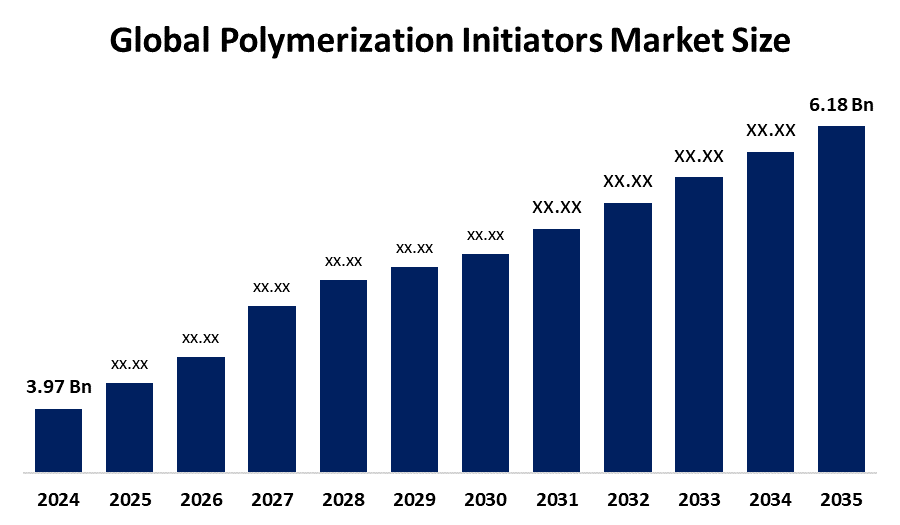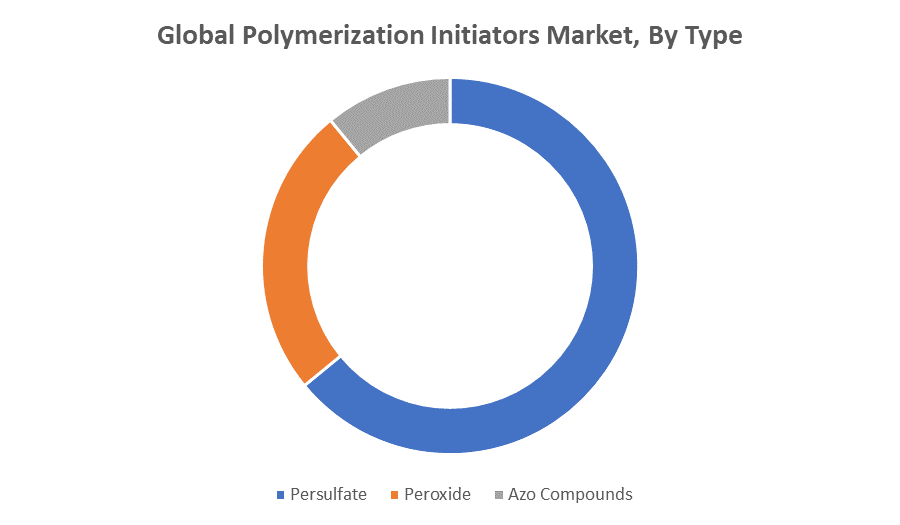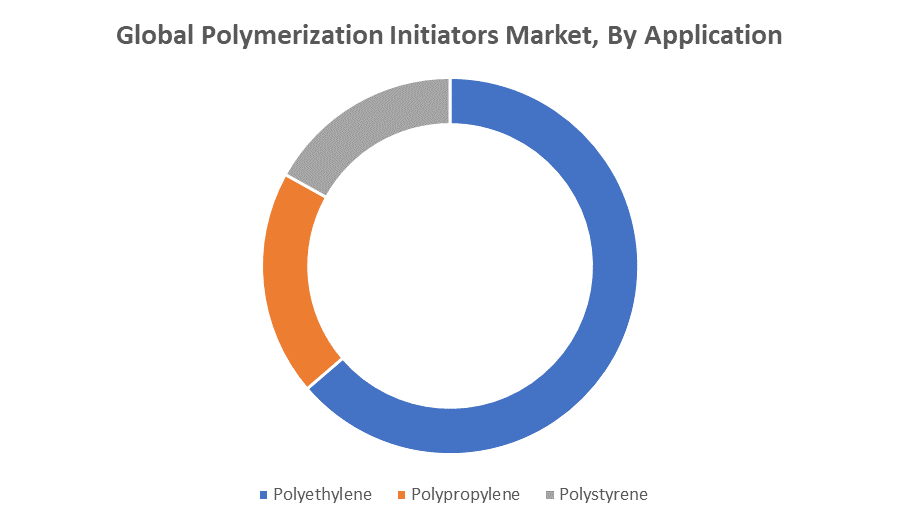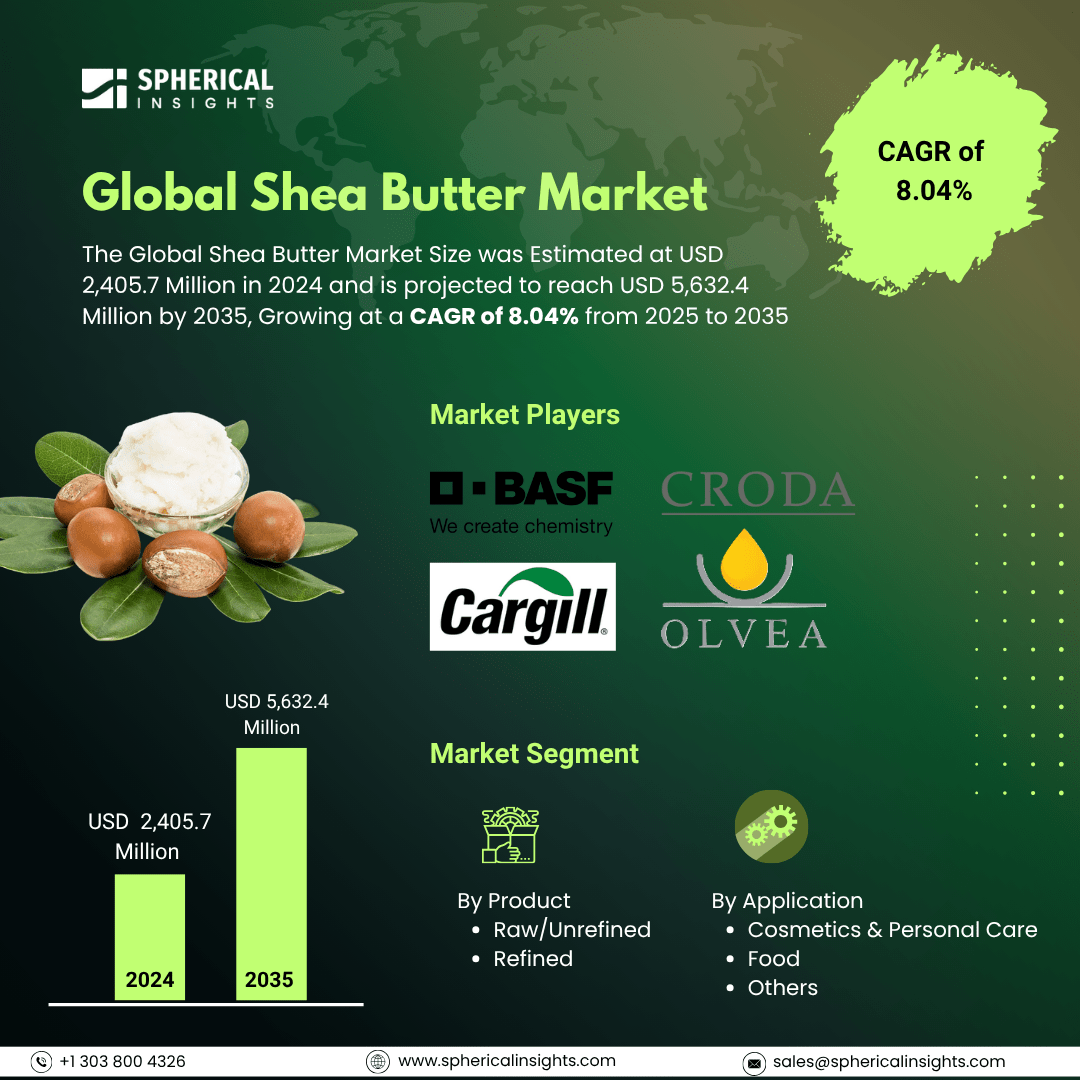Global Polymerization Initiators Market Insights Forecasts to 2035
- The Global Polymerization Initiators Market Size Was Estimated at USD 3.97 Billion in 2024
- The Market Size is Expected to Grow at a CAGR of around 4.11% from 2025 to 2035
- The Worldwide Polymerization Initiators Market Size is Expected to Reach USD 6.18 Billion by 2035
- North America is expected to grow the fastest during the forecast period.

Polymerization Initiators Market
The polymerization initiators market involves chemical compounds that trigger the polymerization process, converting monomers into polymers essential for producing various plastic and rubber materials. These initiators include thermal, photoinitiators, redox, and radiation-based types, each designed to initiate specific polymerization mechanisms such as free-radical, cationic, or anionic polymerization. Polymerization initiators are widely used in manufacturing products like adhesives, coatings, elastomers, and plastics, which find applications across multiple industries including automotive, packaging, electronics, and healthcare. Advances in polymer science have led to the development of initiators with improved efficiency, selectivity, and compatibility with different polymer systems. The market reflects a wide range of formulations tailored to diverse production needs, supporting the creation of high-performance and specialty polymers. Overall, polymerization initiators are indispensable components in the chemical industry, enabling the synthesis of materials that drive innovation and meet evolving industrial requirements worldwide.
Attractive Opportunities in the Polymerization Initiators Market
- The rising environmental awareness and global push for sustainability are accelerating the demand for bio-based and low-toxicity initiators. Manufacturers that develop green alternatives to traditional chemical initiators will gain a competitive edge, especially in markets with strict environmental regulations (e.g., EU, North America).
- The rapid adoption of 3D printing in industries such as aerospace, healthcare, and consumer products increases demand for highly reactive and efficient initiators tailored for fast polymerization. This niche segment presents strong growth potential for initiator suppliers that innovate for additive manufacturing.
- Industrialization, urbanization, and infrastructure development in emerging economies (e.g., India, Southeast Asia, Latin America) are driving demand for plastics and polymers. This creates significant opportunities for initiator manufacturers to expand geographically and tap into untapped or underpenetrated markets.
Global Polymerization Initiators Market Dynamics
DRIVER: Growing consumer preference for lightweight
Growing consumer preference for lightweight, durable, and versatile materials fuels the need for advanced polymers, which rely on efficient initiators. Innovations in polymerization technology, including the development of more effective and selective initiators, enhance polymer quality and production efficiency, further stimulating market growth. Additionally, the rise of environmentally friendly and sustainable polymer production methods encourages the adoption of eco-friendly initiators, aligning with global regulatory standards. Expansion in emerging applications like 3D printing, medical devices, and specialty coatings also boosts demand. Furthermore, the growth of end-use industries and urbanization contribute to increased polymer consumption, thereby increasing the need for polymerization initiators. These combined factors collectively drive the steady expansion and innovation within the polymerization initiators market.
RESTRAINT: Variability in raw material availability and price fluctuations
One significant challenge is the high cost associated with advanced and specialty initiators, which can increase overall production expenses for manufacturers. Additionally, the use of certain initiators involves handling hazardous chemicals, raising safety and environmental concerns that require strict regulatory compliance and can complicate manufacturing processes. Variability in raw material availability and price fluctuations also pose risks to consistent supply and cost management. Furthermore, the presence of alternative polymerization technologies or processes that do not require traditional initiators may limit market demand. Technical complexities in optimizing initiator performance for specific polymers can slow adoption. Lastly, stringent environmental regulations aimed at reducing chemical emissions and waste from polymer production can restrict the use of certain initiators, affecting market dynamics. These factors collectively contribute to challenges that could impede the polymerization initiators market’s growth potential.
OPPORTUNITY: Advances in nanotechnology and controlled/living polymerization techniques
The polymerization initiators market presents several promising opportunities beyond traditional growth drivers. Increasing research and development activities focused on bio-based and sustainable initiators offer potential to meet rising environmental concerns and demand for greener polymers. Advances in nanotechnology and controlled/living polymerization techniques provide opportunities to develop highly precise initiators that enable the creation of tailor-made polymers with enhanced properties. Growing interest in specialty polymers for high-performance applications, such as aerospace, electronics, and biomedical devices, opens new avenues for innovative initiator formulations. Additionally, expanding markets in developing economies with rising industrialization and infrastructure development create fresh demand for polymer-based materials and, consequently, initiators. Collaborations between chemical manufacturers and end-users to develop customized initiators for niche applications further widen the market scope. The increasing adoption of 3D printing and additive manufacturing technologies also offers opportunities for specialized initiators designed for rapid and efficient polymerization processes in these emerging fields.
CHALLENGES: Ensuring consistent performance and compatibility of initiators across a wide range
One major challenge is the need for continuous innovation to keep pace with evolving polymer applications that demand highly specialized initiators with precise control over polymerization. This requires significant investment in R&D and skilled expertise. Additionally, ensuring consistent performance and compatibility of initiators across a wide range of monomers and processing conditions remains difficult, often leading to trial-and-error in formulation development. Market fragmentation and competition from established chemical companies create pressure on smaller players to differentiate their products. Moreover, global supply chain disruptions can impact the availability of key raw materials, affecting production timelines. Intellectual property issues, including patents on novel initiators, may limit access to cutting-edge technologies. Lastly, educating end-users about the benefits and proper handling of advanced initiators is crucial but challenging, potentially slowing adoption rates in certain sectors. These challenges require strategic approaches to sustain growth in the market.
Global Polymerization Initiators Market Ecosystem Analysis
The global polymerization initiators market ecosystem includes chemical manufacturers producing various initiators, raw material suppliers providing key chemicals, and distributors ensuring product availability worldwide. End-users span industries like packaging, automotive, electronics, and healthcare, relying on initiators for producing polymers in adhesives, coatings, and plastics. Regulatory bodies enforce safety and environmental standards, shaping production practices. Additionally, research institutions and technology developers drive innovation in initiator efficiency and sustainability. This interconnected network supports ongoing growth and advancement in the polymerization initiators market.
Based on the type, the persulfate type segment dominated the market with a revenue share over the forecast period

The persulfate segment dominated the global polymerization initiators market, maintaining the largest revenue share throughout the forecast period. This is attributed to persulfates’ strong oxidizing properties, effectiveness in initiating free-radical polymerization, and widespread use in applications such as water treatment, adhesives, and coatings. Their stability, cost-effectiveness, and compatibility with various monomers make persulfates a preferred choice for manufacturers, driving their continued dominance in the polymerization initiators market.
Based on the application, the polyethylene segment dominated the market with a revenue share during the forecast period

The dominance is driven by polyethylene’s extensive use in packaging, automotive, and consumer goods industries due to its versatility, durability, and cost-effectiveness. Polymerization initiators play a crucial role in producing high-quality polyethylene with desired properties, supporting its widespread adoption and sustaining the segment’s leading position in the market.
Asia Pacific is anticipated to hold the largest market share of the polymerization initiators market during the forecast period
Asia Pacific is anticipated to hold the largest market share in the polymerization initiators market during the forecast period. This growth is driven by rapid industrialization, expanding manufacturing sectors, and increasing demand for polymers in packaging, automotive, and electronics industries across the region. Additionally, rising investments in infrastructure and the presence of major chemical manufacturers contribute to the region’s dominance. The growing focus on advanced materials and innovations in polymerization processes further support the strong market position of Asia Pacific in the global polymerization initiators landscape.
North America is expected to grow at the fastest CAGR in the polymerization initiators market during the forecast period
North America is expected to grow at the fastest CAGR in the polymerization initiators market during the forecast period. This rapid growth is fueled by technological advancements, increased adoption of specialty polymers, and strong demand from industries such as automotive, healthcare, and electronics. Additionally, ongoing investments in research and development, along with stringent environmental regulations promoting the use of efficient and eco-friendly initiators, contribute to the region’s accelerated market expansion. Robust infrastructure and a well-established chemical industry further support North America’s leading growth trajectory.
Recent Development
- In May 2024, Arkema acquired Dow's flexible packaging laminating adhesives business. This acquisition is expected to generate annual sales of around USD 250 million for Arkema and expand its portfolio of solutions for flexible packaging, aligning with the company's strategy to offer innovative products with high technological content and continue to grow in the attractive adhesives segment
Key Market Players
KEY PLAYERS IN THE POLYMERIZATION INITIATORS MARKET INCLUDE
- BASF SE
- Arkema S.A.
- LANXESS AG
- Nouryon
- United Initiators GmbH
- Celanese Corporation
- Wanhua Chemical Group Co., Ltd.
- Shanghai Fortune Chemical Co., Ltd.
- DIC Corporation
- Evonik Industries AG
- Others
Market Segment
This study forecasts revenue at global, regional, and country levels from 2020 to 2035. Spherical Insights has segmented the polymerization initiators market based on the below-mentioned segments:
Global Polymerization Initiators Market, By Type
- Persulfate
- Peroxide
- Azo compounds
Global Polymerization Initiators Market, By Application
- Polyethylene
- Polypropylene
- Polystyrene
Global Polymerization Initiators Market, By Regional Analysis
- North America
- Europe
- Germany
- UK
- France
- Italy
- Spain
- Russia
- Rest of Europe
- Asia Pacific
- China
- Japan
- India
- South Korea
- Australia
- Rest of Asia Pacific
- South America
- Brazil
- Argentina
- Rest of South America
- Middle East & Africa
- UAE
- Saudi Arabia
- Qatar
- South Africa
- Rest of the Middle East & Africa






